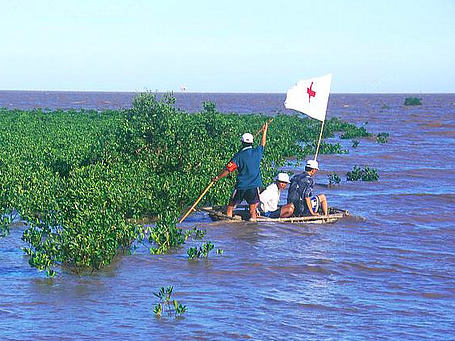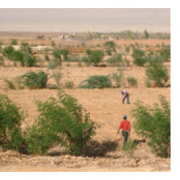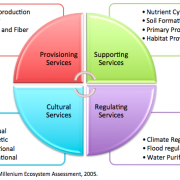Ecosystem Services and Disaster Risk Reduction

Red Cross volunteers monitor the growth of mangroves in Vietnam to reduce the effects of typhoons and large waves. Photo credit: IFRC
Healthy ecosystems and the services they provide help reduce a community’s risk to natural disaster. Conversely, poorly functioning ecosystems increase this risk, ridding a community of its natural protective barriers. As part two of our Ecosystem Services Series, we’ll be taking a look at the role ecosystem services can play in disaster risk reduction (DRR).
Ecosystem services such as flood regulation for example, have the potential to reduce risk in a variety of natural disasters. For example, mangroves have the ability to reduce wave energy of tsunamis up to 70%, and off-short drift and sedimentation help create barrier islands to provide protection for coastal communities. Most ecosystem services for DRR belong to the category of regulatory services, and are greatly impacted environmental degradation. Accordingly, it is important that ecosystems be managed properly, to increase the level of protection they are able to provide.
In addition to their DRR-related benefits, ecosystem services are also a cost-efficient alternative to hard-engineering solutions for natural resource management. China for example, spent $3.15 billion in flood control over the course of four years, avoiding $12 billion that would have incurred otherwise. Similarly, forests also provide an array of ecosystem services with large economic benefits, particularly in avalanche-prone areas. It is estimated that by breaking up snow cover and preventing wind-blow drifts, approximately $100 per hectare per year is saved in areas of open land, while more than $170,000 per hectare per year is saved in areas with valuable assets.
The Coastal Community Resilience (CCR) Initiative exemplifies a DRR program that incorporates both ecosystem services and natural resource management. Implemented throughout the Indian Ocean region, CCR takes a collaborative approach to build resilience to disaster, across the environment and coastal management sectors, involving both government and civil society organizations. It is also important to involve members of a given community, since the majority of environmental degradation results from human actions. Processes such as deforestation or grazing for example, decrease an ecosystem’s ability to perform regulating services efficiently, thereby increasing a community’s risk for disaster. Poorer communities are often more vulnerable to disaster, as their livelihoods depend on many of the other services ecosystems provide, such as food production and income generation. In this respect, natural resource management can play a crucial role in preserving ecosystems, ensuring their functionality for DRR.
Given the amount of damage and loss of life caused by natural disasters, it is important to recognize both the social and fiscal benefits of ecosystem services for DRR. This is not to imply that ecosystem services alone can sufficiently protect against natural disasters, as a combination of hard and soft engineering is most likely also necessary to build up adequate resilience. Areas of natural resource management such as biodiversity conservation and proper land management are also necessary to sustain the quality of life within an ecosystem. It is therefore important that policy officials and community members are informed of the benefits ecosystems have the potential to supply. With the proper knowledge and plan of action, ecosystems can be sustained to better defend populations from disaster worldwide.
Stay tuned next week for the third blog of our Ecosystem Services series, “Natural Resource Management for Increased Food Security”.








































